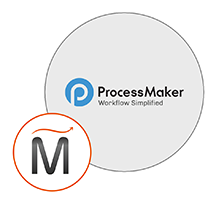ProcessMaker


Please feel free to contact us
Go
ProcessMaker workflow management software allows public and private organizations to automate document intensive, approval-based processes across departments and systems. Business users and process experts with no programming experience can design and run workflows.
Miri Infotech is launching a product which will configure and publish ProcessMaker, workflow management software which is embedded pre-configured tool with LAMP and ready-to-launch AMI on Amazon EC2 that contains ProcessMaker, Apache, MySQL, Linux, PHP (LAMP).
With business processes governing more complex relationships and interacting with many different business systems, companies need an easy way to manage and improve their processes. Several factors make it difficult to manage these processes in human resources, finance, compliance, and other business functions.
You can subscribe to ProcessMaker, an AWS Marketplace product and launch an instance from the ProcessMaker product’s AMI using the Amazon EC2 launch wizard.
Open the URL: http://<instance ip address>/
IP address of the running EC2 instance.
Step 1: Pre Installation Check.
Step 2: File permission.
System Configuration
Step 3: Database Cinfiguration
User: miriprocessmaker
Password : <instanceID>
Database Name : miriprocessmakerdb
Host: localhost
Step 4: Work Space Configuration
Step 5: Installation Finish
SSH using root user is disabled. ec2-user is the sudo user with root privileges with access using the key pair created during launching the instance.
MYSQL can be accessed only with SSH
MYSQL User : root
Password : <instanceID>
Note : You are not supposed to change it.
All your queries are important to us. Please feel free to connect.
24X7 support provided for all the customers.
We are happy to help you.
Submit your Query: https://miritech.com/contact-us/
Contact Numbers:
Contact E-mail:
The Apache Hadoop software library allows for the distributed processing of large data sets across clusters of computers using a simple programming model. The software library is designed to scale from single servers to thousands of machines; each server using local computation and storage. Instead of relying on hardware to deliver high-availability, the library itself handles failures at the application layer. As a result, the impact of failures is minimized by delivering a highly-available service on top of a cluster of computers.
Hadoop, as a scalable system for parallel data processing, is useful for analyzing large data sets. Examples are search algorithms, market risk analysis, data mining on online retail data, and analytics on user behavior data.
Add the words “information security” (or “cybersecurity” if you like) before the term “data sets” in the definition above. Security and IT operations tools spit out an avalanche of data like logs, events, packets, flow data, asset data, configuration data, and assortment of other things on a daily basis. Security professionals need to be able to access and analyze this data in real-time in order to mitigate risk, detect incidents, and respond to breaches. These tasks have come to the point where they are “difficult to process using on-hand data management tools or traditional (security) data processing applications.”
The Hadoop JDBC driver can be used to pull data out of Hadoop and then use the DataDirect JDBC Driver to bulk load the data into Oracle, DB2, SQL Server, Sybase, and other relational databases.
Front-end use of AI technologies to enable Intelligent Assistants for customer care is certainly key, but there are many other applications. One that I think is particularly interesting is the application of AI to directly support — rather than replace — contact center agents. Technologies such as natural language understanding and speech recognition can be used live during a customer service interaction with a human agent to look up relevant information and make suggestions about how to respond. AI technologies also have an important role in analytics. They can be used to provide an overview of activities within a call center, in addition to providing valuable business insights from customer activity.
There are many machine learning algorithms in use today, but the most popular ones are:
Radically Reduced Paperwork, Rest API, BPMN 2.0 Process Designer
Email Client Integrations, Gmail, Outlook, Advanced LDAP/AD
It provides Business Rules, Single sign On, Batch Routing, SLA Manager, FTP Monitor, Enterprise Connectors
 ProcessMaker
ProcessMaker  apache
apache  linux
linux  hadoop
hadoop